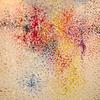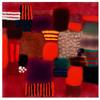Calder's Use of Motion and Sound to be Explored in Summer Exhibition at Whitney
- NEW YORK, New York
- /
- January 30, 2017
In the early 1930s, Alexander Calder (1898–1976) invented an entirely new mode of art, the mobile—a kinetic form of sculpture in which carefully balanced components manifest their own unique systems of movement. These works operate in highly sophisticated ways, ranging from gentle rotations to uncanny gestures, and at times trigger unpredictable percussive sounds. In Calder's own words, "Just as one can compose colors, or forms, so one can compose motions.” Calder: Hypermobility, opening on June 9 at the Whitney Museum of American Art, focuses on the extraordinary breadth of motion achieved by Calder from the moment he turned to radical abstraction in 1930 and continuing throughout the subsequent decades of his career.
This exhibition brings together a rich constellation of key works, some of which will be activated regularly in the gallery to more fully elucidate their inherent motion and their relationship to performance as well as the theatrical stage. In addition to the gallery display, a central component of the exhibition is an expansive series of performances and events, including a number of episodic, one-time demonstrations of additional rarely seen works overseen and led by the Calder Foundation, as well as concerts, screenings, and special programs. New commissions will bring contemporary artists into dialogue with Calder as these artists interplay their own practices with Calder’s innovations, revealing the many ways in which his art continues to challenge and inform new generations.
Organized by Jay Sanders, Engell Speyer Family Curator and Curator of Performance, with Greta Hartenstein, senior curatorial assistant, and Melinda Lang, curatorial assistant, the exhibition opens in the Museum’s eighth-floor Hurst Family Galleries on June 9 and runs through October 16, 2017. Thanks to an unprecedented collaboration with the Calder Foundation, the Whitney’s exhibition will provide visitors with a rare opportunity to experience works as the artist intended—activated by motors or air currents and further animated by touch.
Whitney curator Jay Sanders notes: “Encompassing a vast array of engineered forms, Calder's artistic practice transformed the parameters of artmaking through an unceasing exploration of movement and sound. As its title suggests, Calder: Hypermobility gathers important objects to reveal specifically the diverse taxonomy of movements within Calder's work.” This selection of works draws inspiration from Calder’s notion of “disparity”—a term the artist used to describe the complex variation and disjuncture of forms, colors, densities, and movements within a single work and across multiple objects. The exhibition intersperses works from different time periods, offering compelling juxtapositions of boldly contrasting yet thematically connected works.
Calder: Hypermobility encompasses major examples of Calder’s work, including his early motor-driven abstractions and wall panels with suspended active elements, as well as his sound-generating Gongs and standing and hanging mobiles, among others. Newly restored motorized sculptures will be activated for the first time in eighty years, including at least one work that has never previously been exhibited, revealing their original movements and intentions. Influenced in part by the artist’s fascination and engagement with choreography, Calder’s sculptures contain an embedded performativity that is reflected in their idiosyncratic motions and the perceptual responses they provoke in the viewer. Even in his stationary works, a sense of implied movement, deliberate staging, and unfolding complexity is palpable.
The Whitney has long been dedicated to the work and legacy of Alexander Calder. As a young artist, Calder became a member of the Whitney Studio Club and soon after, in 1926, he participated in the Studio’s Eleventh Annual Exhibition. Following his inclusion in numerous Whitney Annuals in the 1940s, the museum began to grow deep holdings of the artist’s work. In the 1970s, Calder lent one of his most beloved works to the Whitney—the Cirque Calder, which the museum purchased in 1983 and committed further resources to restoring in the 2000s. Calder has been the subject of many exhibitions at the Whitney, including Alexander Calder: Tapestries (1971), Calder’s Circus (1972), Three Sculptors: Calder, Nevelson and Smith (1974), Alexander Calder: Sculpture of the Nineteen Thirties (1987–88), Celebrating Calder (1991), I Think Best In Wire: Alexander Calder (2006), Alexander Calder: The Paris Years, 1926–33 (2008–09), and Collecting Calder (2014). In 1976, the Whitney mounted a major retrospective on Calder, which opened just before the artist’s death. Today, the Whitney’s collection is the largest repository of Calder’s work in the world.










100x100_c.jpg)


